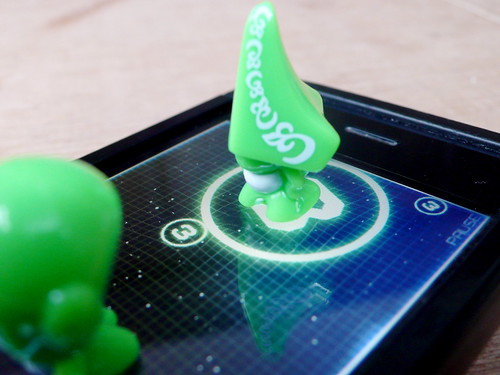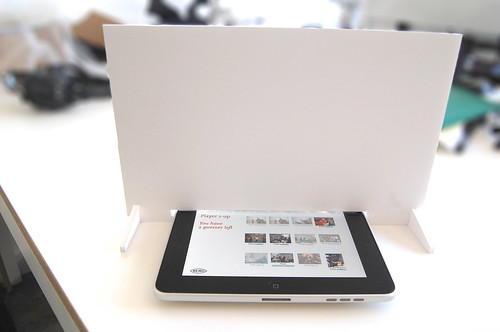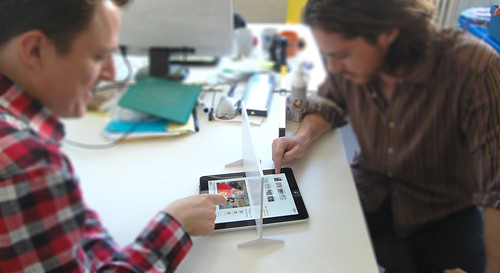A while back, in 2007, I wrote about ‘a lost future’ of touch technology, and the rise of a world full of mobile glowing attention-wells.
“…it’s likely that we’re locked into pursuing very conscious, very gorgeous, deliberate touch interfaces – touch-as-manipulate-objects-on-screen rather than touch-as-manipulate-objects-in-the-world for now.”
It does look very much like we’re living in that world now – where our focus is elsewhere than our immediate surroundings – mainly residing through our fingers, in our tiny, beautiful screens.

Andrew Blum writes about this, amongst other things, in his excellent piece “Local Cities, Global Problems: Jane Jacobs in an Age of Global Change”:
Like a lot of things here, they are deeply connected to other places. Their attention is divided. And, by extension, so is ours. While this feeling is common to all cities over time, cell phones bring the tangible immediacy of the faraway to the street. Helped along by media and the global logistics networks that define our material lives, our moment-to-moment experience of the local has become increasingly global.
Recently, of course, our glowing attention wells have become larger.
We’ve been designing, developing, using and living with iPads in the studio for a while now, and undoubtedly they are fine products despite their drawbacks – but it wasn’t until our friend Tom Coates introduced me to a game called Marble Mixer that I thought they were anything other than the inevitable scaling of an internet-connected screen, and the much-mooted emergence of a tablet form-factor.
It led me to think they might be much more disruptive as magic tables than magic windows.
Marble Mixer is a simple game, well-executed. Where it sings is when you invite friends to play with you.
Each of you occupy a corner of the device, and attempts to flick marbles into the goal-mouth against the clock – dislodging the other’s marbles.
Beautiful. Simple. But also – amazing and transformative!
We’re all playing with a magic surface!
When we’re not concentrating on our marbles, we’re looking each other in the eye – chuckling, tutting and cursing our aim – and each other.
There’s no screen between us, there’s a magic table making us laugh. It’s probably my favourite app to show off the iPad – including the ones we’ve designed!
It shows that the iPad can be a media surface to share, rather than a proscenium to consume through alone.
Russell Davies pointed this out back in February (before we’d even touched one) saying:
[GoGos]’d be the perfect counters for a board game that uses the iPad as the board. They’d look gorgeous sitting on there. We’d need to work out how to make the iPad think they were fingers – maybe some sort of electrostatic sausage skin – and to remember which was which.
Inspired by Marble Mixer, and Russell’s writings – I decided to do a spot of rapid prototyping of a ‘peripheral’ for magic table games that calls out the shared-surface…
It’s a screen – but not a glowing one! Just a simple bit of foamboard cut so it obscures your fellow player’s share of the game board, for games like Battleships, or in this case – a mocked-up guessing-game based on your flickr contacts…
You’d have a few guesses to narrow it down… Are they male, do they have a beard etc…
Fun for all the family!
Anyway – as you can see – this is not so serious a prototype, but I can imagine some form of capactive treatment to the bottom edge of the screen, perhaps varying the amount of secret territory each player revealed to each other, or capacitive counters as Russell suggests.
Aside from games though – the pattern of a portable shared media surface is surely worth pursuing.
As Paul Dourish put it in his book “Where the action is” – the goal would be
“interacting in the world, participating in it and acting through it, in the absorbed and unreflective manner of normal experience.”
Designing media and services for “little-ass” rather than “big-ass” magic tables might propel us into a future not so removed from the one I thought we might have lost…




12 Comments and Trackbacks
1. Tina said on 18 June 2010...
This is exactly what I’ve been excited about in terms of the potential of the iPad. The screen is just big enough for more than one person’s hands to be on it. Hoping for a renaissance of boardgames, perhaps with some that come alive, Jumanji-style, or with physical pieces to “break through” the glass. Someone was working on physical knobs that you could place on the surface and twist in different orientations–they had a demo of the knob turning a map, but I could imagine some really fun interactive-force-field strategic play coming out of that sort of thing. Intersecting colors/webs/sounds for pieces to navigate past or areas to control? In any case, finally a platform for something really new. Can’t wait.
2. mac morrison said on 18 June 2010...
And why oh why have microsoft sat on surface for 3? or 4? years.
Surface really excited me to new possibilities to lose the interface metaphors that have come though by accident rather than need or desire.
Current OS’s are like a set of concreate paths carefully placed in a park, which of course everyone blatantly ignore to get where they want to be. Leaving behind a well trodden and obvious path of crushed grass.
Let’s all walk barefoot on the grass.
3. Lachlan Hardy said on 20 June 2010...
I’m still waiting for BattleChess. Hell, I’m so keen I’m considering making it.
Imagine, pinching your fingers together to pick up tiny pawns by the scruff of their neck and propel them forward to their inevitable sad fate as steelclad knights hack them down with shouts of glory and victory.
The iPad is *perfect* for BattleChess.
4. Amit said on 23 June 2010...
Lovely idea. They key step forward would be the ability to recognise objects placed on the iPad, opening up board games.
Not sure how well you could go on shape and size. If only an object could communicate it’s identity to the surface – through some slight voltage 😉 Some games where information exists in bubbles that don’t reveal things to each other [on the play-canvas] might work well.
I guess if three iPads could interact and two were used to divide up the halves of one pad, that would make a nice 3d experience for a two-player on both sides!
5. Toby barnes said on 9 July 2010...
“Has a beard?”, is never going to win that game is it?
Trackback: Have your Surface at Alper.nl 18 June 2010
[…] Haven’t got mine yet, but yes they’re Magic Tables. […]
Trackback: iPad prototyping inspired Russell Davies post pre-iPad - Starters for 10 22 June 2010
[…] iPad prototyping inspired Russell Davies post pre-iPad By Rob Forshaw | Published: June 22, 2010 via berglondon.com […]
Trackback: Fast Prototyping WoT Apps with NIWEA | Web of Things 29 June 2010
[…] eyes towards what it means beyond just an iPhone with a bigger screen, especially in terms of HCI. As explained by Matt Jones, the novel types of multi-users/-touch interactions enabled by such a larger display offers a fresh […]
Trackback: iPads, laptops, and social interaction 5 July 2010
[…] if the laptop is a wall, then the iPad is a pool – something to dive down into. Or as Matt Jones observes, a magic table. Writing about the experience of playing Marble Mixer on the iPad, he notes that […]
Trackback: Magic Tables, Not Magic Windows 23 July 2010
[…] According to Matt Jones, in interacting with computer screens, there are two basic choices – either falling into a deep “attention well” or to use computers and mobile phones as supplemental devices to the business of people living in the world. In the first case we are isolated in our own sensory experiences, in the second we interact with each other with the electronic media being a catalyst. For example using the Apple iPad as surface for a board game between two people is a much more social experience than playing an online game where you have no real sense of the human qualities of the person(s) you are playing against. […]
Trackback: Science Hack Day: OpenDirtMap | iPad Softly 5 April 2011
[…] Science Hack Day: OpenDirtMap Image by moleitau Checking a soil sample against a Munsell colour chart, using an iPad as a magic table. […]
Trackback: Four short links: 22 June 2010 - O'Reilly Radar 18 September 2012
[…] Magic Tables, not Magic Windows (Matt Jones) — thoughtful piece about how touch-screens are rarely used as a controller of abstract things rather than of real things, with some examples of the potential he’s talking about. When we’re not concentrating on our marbles, we’re looking each other in the eye – chuckling, tutting and cursing our aim – and each other. There’s no screen between us, there’s a magic table making us laugh. It’s probably my favourite app to show off the iPad – including the ones we’ve designed! It shows that the iPad can be a media surface to share, rather than a proscenium to consume through alone. […]